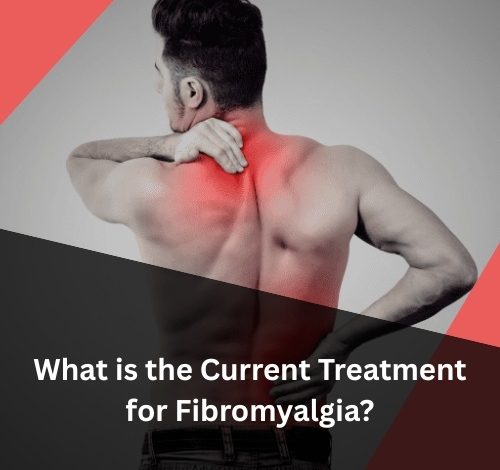What is the Current Treatment for Fibromyalgia?

Fibromyalgia is a long-term, chronic condition characterized by widespread musculoskeletal pain, fatigue, sleep disturbances, cognitive dysfunction (often called “fibro fog”), and emotional distress. Affecting millions worldwide—particularly women—fibromyalgia remains a challenging condition due to its complex symptoms and uncertain causes.
While there is no cure for fibromyalgia, various treatment strategies have evolved over the years to manage its symptoms and improve the quality of life for those affected. The current treatment for fibromyalgia, including medications, lifestyle changes, alternative therapies, and the emerging approaches that offer new hope.
Understanding Fibromyalgia
Before delving into the treatment for fibromyalgia, it is important to understand what causes it. Although the exact cause is still unknown, researchers believe that fibromyalgia is linked to how the brain and spinal cord process pain signals. This abnormal sensory processing may cause a heightened response to stimuli that are not typically painful.

Some common triggers or contributing factors include:
- Genetic predisposition
- Physical or emotional trauma
- Infections
- Autoimmune conditions
- Chronic stress
Fibromyalgia symptoms often overlap with other conditions such as chronic fatigue syndrome, irritable bowel syndrome, depression, and rheumatoid arthritis. Therefore, accurate diagnosis and individualized treatment are key.
Current Medical Treatment for Fibromyalgia
Medical treatments for fibromyalgia focus on symptom management rather than a cure. These may include FDA-approved medications, off-label drugs, and a combination of pharmacological and non-pharmacological approaches.
1. FDA-Approved Medications
Currently, three medications are approved by the U.S. Food and Drug Administration (FDA) specifically for fibromyalgia:
a. Pregabalin (Lyrica)
Pregabalin is an anticonvulsant that helps reduce nerve-related pain and improve sleep. It works by calming overactive nerve signals associated with fibromyalgia.
b. Duloxetine (Cymbalta)
An SNRI (serotonin-norepinephrine reuptake inhibitor), duloxetine is primarily used as an antidepressant. It also helps alleviate pain and improve mood and sleep.
c. Milnacipran (Savella)
Another SNRI, milnacipran works similarly to duloxetine and is specifically indicated for fibromyalgia. It helps reduce fatigue and improve physical function.
2. Off-Label Medications
Many medications not specifically approved for fibromyalgia are used off-label based on clinical experience and patient response:
- Tricyclic antidepressants like amitriptyline can improve sleep and reduce pain.
- Muscle relaxants such as cyclobenzaprine may ease muscle spasms.
- NSAIDs (non-steroidal anti-inflammatory drugs) like ibuprofen can offer temporary pain relief, although they are not very effective for central pain.
- Low-dose naltrexone (LDN) is being explored for its potential anti-inflammatory and immune-modulating effects.
Non-Pharmacological Treatment for Fibromyalgia
Medication alone is rarely sufficient for managing fibromyalgia. Most patients benefit from a holistic, multidisciplinary treatment plan that includes physical, psychological, and lifestyle interventions.
1. Exercise and Physical Activity
Regular physical activity is one of the most effective treatments for fibromyalgia, though it can be challenging due to chronic pain and fatigue. Studies have shown that low-impact aerobic exercise can:
- Reduce pain sensitivity
- Improve sleep quality
- Enhance mood
- Boost energy levels
Recommended forms of exercise include:
- Walking
- Swimming
- Water aerobics
- Gentle yoga
- Tai Chi
- Pilates
Start slowly and increase intensity gradually to avoid symptom flare-ups.
2. Cognitive Behavioral Therapy (CBT)
CBT is a widely used psychological therapy that teaches coping strategies for dealing with pain, stress, and negative thought patterns. It can:
- Help manage anxiety and depression
- Improve self-efficacy
- Reduce perceived pain intensity
- Encourage better sleep hygiene
Group or individual CBT sessions, combined with other therapies, are often part of a comprehensive treatment for fibromyalgia.
3. Mind-Body Techniques
Stress reduction plays a major role in fibromyalgia management. Techniques that promote relaxation and emotional well-being include:
- Mindfulness meditation
- Deep breathing exercises
- Progressive muscle relaxation
- Biofeedback
- Guided imagery
These approaches help regulate the autonomic nervous system and reduce central sensitization.
4. Sleep Management
Fibromyalgia patients often suffer from non-restorative sleep, which worsens other symptoms. Treatment focuses on improving sleep hygiene and may include:
- Establishing a regular sleep schedule
- Avoiding caffeine and screen time before bed
- Using sleep-promoting supplements (like melatonin)
- Treating underlying sleep disorders (e.g., sleep apnea or restless leg syndrome)
If necessary, medications like low-dose amitriptyline or trazodone may be prescribed.
Complementary and Alternative Medicine (CAM) in Fibromyalgia
Many fibromyalgia patients seek relief through alternative therapies. While evidence varies, some complementary treatments show promise when integrated with conventional care.
1. Acupuncture
Acupuncture has been shown in several studies to reduce pain and improve quality of life in fibromyalgia patients. It may help regulate neurotransmitters and blood flow in pain-processing areas of the brain.
2. Massage Therapy
Massage can temporarily reduce muscle tension, improve circulation, and promote relaxation. Techniques like myofascial release and trigger point therapy are commonly used.
3. Chiropractic Care
Spinal manipulation and other manual therapies can help relieve tension and improve mobility, though results are mixed and may depend on the practitioner’s experience with fibromyalgia.
4. Herbal Supplements
Some supplements may help reduce symptoms:
- Magnesium – may relieve muscle cramps and fatigue
- Vitamin D – important for immune and musculoskeletal health
- 5-HTP – a serotonin precursor that may enhance mood and sleep
- SAMe – supports neurotransmitter balance and energy production
- Turmeric/Curcumin – anti-inflammatory and antioxidant properties
Always consult a healthcare provider before starting any supplement regimen.
Dietary Considerations in Fibromyalgia Treatment
There is no specific “fibromyalgia diet,” but some people report symptom improvement by eliminating certain foods or following particular diets:
- Anti-inflammatory diet: Focuses on whole, unprocessed foods, including fruits, vegetables, whole grains, lean protein, and healthy fats.
- Gluten-free diet: Some fibromyalgia patients with gluten sensitivity have reported decreased pain and fatigue after removing gluten.
- Low FODMAP diet: Originally designed for IBS, this diet may help those with overlapping gastrointestinal symptoms.
- Avoiding food additives: Aspartame, MSG, and certain preservatives may trigger symptoms in sensitive individuals.
Staying hydrated, reducing caffeine and alcohol, and maintaining steady blood sugar through small, balanced meals can also help.
Emerging and Experimental Treatments
Medical research continues to explore new ways to treat fibromyalgia. Some promising approaches include:
1. Neuromodulation Therapies
These techniques aim to alter nerve activity to reduce pain and improve function.
- Transcranial Magnetic Stimulation (TMS): Uses magnetic fields to stimulate specific areas of the brain.
- Transcutaneous Electrical Nerve Stimulation (TENS): Applies electrical impulses to nerves to reduce pain.
2. Ketamine Infusions
Low-dose ketamine, an NMDA receptor antagonist, has shown promise in reducing central pain in fibromyalgia. It is still considered experimental and used off-label.
3. Medical Cannabis
Cannabinoids like CBD and THC may reduce pain perception, improve sleep, and reduce anxiety. Some patients report significant relief, but clinical evidence is still evolving.
Multidisciplinary Pain Management
Because fibromyalgia is a multifactorial condition, multidisciplinary treatment is often the most effective. This may involve:
- Rheumatologists
- Neurologists
- Pain specialists
- Physical therapists
- Psychologists
- Nutritionists
Pain clinics or integrative medicine centers offer team-based care designed to tailor a treatment plan to each patient’s specific needs.
Living with Fibromyalgia: Self-Care Strategies
Beyond clinical treatment, daily self-management plays a crucial role in reducing the impact of fibromyalgia. Key self-care strategies include:
- Pacing activities: Avoid overexertion by balancing activity with rest.
- Tracking symptoms: Use a journal or app to identify patterns and triggers.
- Building a support system: Joining support groups or connecting with others can reduce isolation and stress.
- Practicing acceptance and resilience: Accepting the chronic nature of fibromyalgia can help shift focus to long-term wellness and management.
Final Thoughts
The current treatment for fibromyalgia is multidimensional, aiming to reduce pain, manage fatigue, improve sleep, and enhance emotional well-being. There is no one-size-fits-all solution, and treatment must be personalized, holistic, and often involves a combination of medications, therapy, lifestyle adjustments, and alternative approaches.
If you or someone you know is living with fibromyalgia, remember that relief is possible—with a proactive and informed treatment plan, many individuals find ways to manage their symptoms and live fulfilling lives.
Key Takeaways
- Fibromyalgia is a chronic pain disorder with no known cure but many treatment options.
- FDA-approved drugs like Lyrica, Cymbalta, and Savella help manage symptoms.
- Exercise, CBT, sleep therapy, and stress management are core non-drug treatments.
- Complementary therapies like acupuncture and supplements offer additional support.
- A personalized, multidisciplinary treatment plan is most effective for long-term management.




